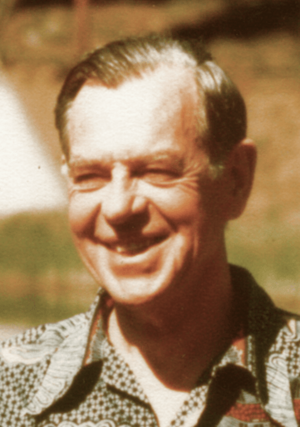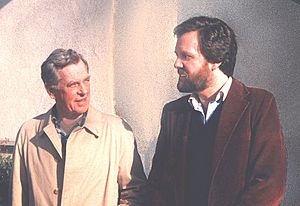Joseph Campbell facts for kids
Quick facts for kids
Joseph Campbell
|
|
|---|---|

Campbell in the late 1970s
|
|
| Born |
Joseph John Campbell
March 26, 1904 White Plains, New York, U.S.
|
| Died | October 30, 1987 (aged 83) Honolulu, Hawaii, U.S.
|
| Education | Dartmouth College Columbia University (BA, MA) |
|
Notable work
|
The Hero with a Thousand Faces (1949) |
| Spouse(s) | |
| Scientific career | |
| Institutions | Sarah Lawrence College |
| Academic advisors | Roger Sherman Loomis |
| Influences | |
| Influenced |
|
Joseph John Campbell (March 26, 1904 – October 30, 1987) was an American writer. He was a professor of literature at Sarah Lawrence College who worked in comparative mythology and comparative religion. His work covers many aspects of the human experience. Campbell's best-known work is his book The Hero with a Thousand Faces (1949).
Since the publication of The Hero with a Thousand Faces, Campbell's theories have been applied by a wide variety of modern writers and artists. His philosophy has been summarized by his own often repeated phrase: "Follow your bliss." He gained recognition in Hollywood when George Lucas credited Campbell's work as influencing his Star Wars saga.
Life
Background
Joseph Campbell was born in White Plains, New York, on March 26, 1904, the elder son of hosiery importer and wholesaler Charles William Campbell, from Waltham, Massachusetts, and Josephine (née Lynch), from New York. Campbell was raised in an upper-middle-class Irish Catholic family; he related that his paternal grandfather Charles had been "a peasant" who came to Boston from County Mayo in Ireland, and became the gardener and caretaker at the Lyman estate at Waltham, where his son Charles William Campbell grew up and became a successful salesman at a department store prior to establishing his hosiery business. During his childhood, he moved with his family to New Rochelle, New York.
In 1921, Campbell graduated from the Canterbury School in New Milford, Connecticut. While at Dartmouth College he studied biology and mathematics, but decided that he preferred the humanities. He transferred to Columbia University, where he received a Bachelor of Arts degree in English literature in 1925 and a Master of Arts degree in medieval literature in 1927. At Dartmouth he had joined Delta Tau Delta. An accomplished athlete, he received awards in track and field events, and, for a time, was among the fastest half-mile runners in the world.
In 1924, Campbell traveled to Europe with his family. On the ship during his return trip he encountered the messiah elect of the Theosophical Society, Jiddu Krishnamurti; they discussed Indian philosophy, sparking in Campbell an interest in Hindu and Indian thought. In 1927, he received a fellowship from Columbia University to study in Europe. Campbell studied Old French, Provençal, and Sanskrit at the University of Paris and the University of Munich. He learned to read and speak French and German.
On his return to Columbia University in 1929, Campbell expressed a desire to pursue the study of Sanskrit and modern art in addition to medieval literature. Lacking faculty approval, Campbell withdrew from graduate studies. Later in life he jested that it is a sign of incompetence to have a PhD in the liberal arts, the discipline covering his work.
The Great Depression
With the arrival of the Great Depression, Campbell spent the next five years (1929–1934) living in a rented shack in Woodstock, New York. There, he contemplated the next course of his life while engaged in intensive and rigorous independent study. He later said that he "would divide the day into four three-hour periods, of which I would be reading in three of the three-hour periods, and free one of them ... I would get nine hours of sheer reading done a day. And this went on for five years straight."
Campbell continued his independent reading while teaching for a year in 1933 at the Canterbury School in Connecticut, during which time he also attempted to publish works of fiction. While teaching at the Canterbury School, Campbell sold his first short story Strictly Platonic to Liberty magazine.
Sarah Lawrence College
In 1934, Campbell accepted a position as Professor of Literature at Sarah Lawrence College in Yonkers, New York. In 1938, he married one of his former students, the dancer-choreographer Jean Erdman. For most of their 49 years of marriage they shared a two-room apartment in Greenwich Village in New York City. In the 1980s they also purchased an apartment in Honolulu and divided their time between the two cities. They did not have any children.
Early in World War II, Campbell attended a lecture by the Indologist Heinrich Zimmer; the two men became good friends. After Zimmer's death, Campbell was given the task of editing and posthumously publishing Zimmer's papers, which he would do over the following decade.
In 1955–1956, as the last volume of Zimmer's posthumous (The Art of Indian Asia, Its Mythology and Transformations) was finally about to be published, Campbell took a sabbatical from Sarah Lawrence College and traveled, for the first time, to Asia. He spent six months in southern Asia (mostly India) and another six in East Asia (mostly Japan). This year had a profound influence on his thinking about Asian religion and myth, and also on the necessity for teaching comparative mythology to a larger, non-academic audience.
In 1972, Campbell retired from Sarah Lawrence College, after having taught there for 38 years.
Later life and death
Campbell attended a Grateful Dead concert in 1986, and marveled that "Everyone has just lost themselves in everybody else here!" With the Grateful Dead, Campbell put on a conference called "Ritual and Rapture from Dionysus to the Grateful Dead".
Campbell died at his home in Honolulu, Hawaii, on October 30, 1987, from complications of esophageal cancer. Before his death he had completed filming the series of interviews with Bill Moyers that aired the following spring as The Power of Myth. He is buried in O'ahu Cemetery, Honolulu.
See also
 In Spanish: Joseph Campbell para niños
In Spanish: Joseph Campbell para niños


